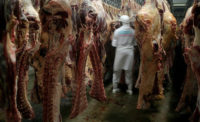Regulations & Legislation
FSIS Salmonella and Campylobacter performance standards
FSIS has finalized its new approach to Salmonella/Campylobacter performance standards.

On Feb. 11, 2016, the Food Safety and Inspection Service (FSIS) published a Federal Register Notice to finalize new Salmonella and Campylobacter performance standards for comminuted poultry and chicken parts. Additionally, the notice adopts the agency’s new approach to Salmonella and Campylobacter verification through a 52-week moving window and adopts new procedures for responding to positive samples, including posting the names of establishments on the Web and initiating enforcement actions. The new procedures are effective for broiler and turkey carcasses beginning May 11, 2016, and for comminuted poultry and chicken parts on May 11, 2017 (although, as noted below, the agency may take action on comminuted poultry and chicken parts sooner in certain circumstances).
Sampling window and determination of category: To determine compliance with the standards, FSIS will use a 52-week moving window approach. Large establishments will be sampled weekly and compliance will be determined by the permitted number of positives out of the last 52 samples taken. For other establishments, the agency will incrementally decrease the number of samples taken based on production volume, so lower-volume establishments will be tested less frequently. If there are less than 52 samples collected during a year, FSIS would use the percentage to determine compliance with the standards. In all cases, FSIS will collect a minimum number of samples (as specified in the notice) to determine process control.
It should be noted that FSIS has indicated it may determine compliance (and take action) before the end of a moving window, provided the minimum number of samples are taken. This may happen where the minimum number of samples taken and noncompliance rates suggests overall performance is not improving or is worsening before completion of the first moving window.
As in the proposed notice, establishments will be categorized for Salmonella performance as follows:
Category 1: Establishments operating at 50 percent or less of the maximum allowable percent positive during all completed 52-week moving window over the last three months.
Category 2: Establishments that meet the performance standard but had more than 50 percent of the maximum allowable positives during any completed 52-week moving window.
Category 3: Establishments that failed the performance standard during any completed 52-week moving window.
For Campylobacter, establishments will be categorized as either passing or failing based on all completed 52-week moving windows over the last three months.
Web posting/enforcement: To drive improvement, FSIS will post on its Web site the performance category for all establishments (even Category 1) on a monthly basis. The monthly posting will be updated based on all completed 52-week moving window tests over the last three months.
The agency will also schedule a Public Health Risk Evaluation (PHRE) at establishments that:
- Fail the performance standard;
- Have agency positives associated with (1) serotypes of public health concern, (2) antibiotic resistant strains, or (3) illnesses that match the same pulsed-field gel electrophoresis (PFGE) or Whole Genome Sequencing pattern; or
- Have been epidemiologically linked to an illness (if an establishment fails the performance standard, FSIS will monitor CDC PulseNet database and search official sequencing data base to determine whether there are matches between product samples and illnesses).
Based on the PHRE, FSIS will determine whether to schedule a Food Safety Assessment. Moreover, if an establishment has failed the standard, the agency will collect additional samples on a daily or per-shift basis and use the results in the moving window to determine compliance. If after 90 days the establishment has not been able to demonstrate process control based on the results of the follow-up sampling, PHRE and FSA, the agency will likely issue a Notice of Intended Enforcement or Notice of Suspension. Such actions would not be based on failure of the performance standard alone.
Given the ramifications of posting and potential enforcement actions, it would be prudent for establishments to use this time to reassess their Salmonella and Campylobacter controls and adopt improvements, if necessary, before the implementation dates. NP
Performance standards: The agency’s final performance standards for comminuted poultry and chicken parts remain unchanged from that proposed in 2015:
Product Salmonella Standard Campylobacter Standard
Comminuted Chicken 13/52 or 25.0% 1/52 or 1.9%
Comminuted Turkey 7/52 or 13.5% 1/52 or 1.9%
Chicken Parts 8/52 or 15.4% 4/52 or 7.7%
(legs, wings, and breast)
Looking for a reprint of this article?
From high-res PDFs to custom plaques, order your copy today!










